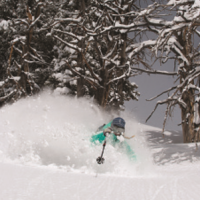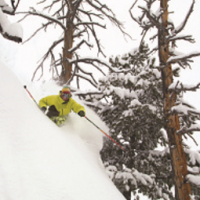Solitude, Utah – Lonely At The Top
THE QUIET COUSIN TO PARK CITY’S BUSTLE, SOLITUDE IS A BIG SECRET — FOR NOW
BY ROGER TOLL
A decade ago, I earned my season pass to Park City Mountain Resort by skiing visitors around the slopes as a mountain host. One of my colleagues — a gentleman who, after a Utah-style snowfall, had a hard time following the rule about staying on groomers when in uniform — shared with me his ultimate secret to in-bounds skiing in the Wasatch Mountains. “Solitude,” he whispered to me over lunch, his lips no more than a few inches from my ear as though passing on state secrets, “on a powder day.”

I cocked a doubtful eye his way. “Really? Not Alta?” “Where the powder disappears by 11?” he shot back. He had a point; you had to be on your game to beat the legions of Alta regulars, forever a run or two ahead of you on the best slopes. A few weeks later, I took his advice and made my way to Solitude after a 12-hour dump. There were perhaps 30 people on the mountain that snow-gilded day, and every line I took offered powder up to my thighs and above. The mountain was truly spectacular. And, living up to its name, it was empty.
Last winter, and no longer a Park City resident, I returned to Solitude after a multiyear absence to fi gure out how this famously uncrowded resort survives. Once I located a member of the family who owns it, it was not hard to find out. “Our desire is to run the resort as a place where we ourselves want to live, work, and ski,” said Dave DeSeelhorst, the area’s general manager. “Sure, we need a certain number of skiers to pay the bills. But we enjoy being here and recreating here the way it is: quiet, friendly, simple.
So it’s how we want to keep it. It’s not just a business to us.” Gary DeSeelhorst, Dave’s father, joined a group that bought Solitude in the late ’70s, then bought out the others a few years later. He and his wife, Betsy, are a ubiquitous presence as full-time residents of Creekside, one of four condo buildings in Solitude’s diminutive neoBavarian village, which sits right at the base of the slopes and across a pathway from the Inn at Solitude — the sole hotel — where I ran into him by chance. “The day we stop enjoying our resort is the day we leave the business,” he told me, echoing his son’s words. “This is our home. This is the family farm.”
It’s that hominess, along with some extraordinary expert terrain and a near total absence of lift lines, which makes loyalists love this resort-on-a-human-scale. They tend to be families who enjoy sharing evenings together reading or playing a game, and couples who prefer a quiet, refined refuge to a bustling resort’s menu of activities and packs of people. In mid-January, no more than a quarter of the Inn’s 46 rooms were occupied. At the hotel’s excellent restaurant, St. Bernard’s, I was alone until a British couple arrived and, perhaps feeling the need for company, took the table next to mine. Within 10 minutes of cross-table chat, I had joined them. “Why is it so quiet here?” they asked, dumbfounded by the dearth of guests in the restaurant, in the village, and on the slopes where they had been skiing all day. “We usually ski in the Alps, and this certainly is quieter than anywhere in Europe. It’s like skiing at a private club.”
With a day pass priced at a mere $72, the ski area seems like a giveaway compared with the $100-plus price tags of top resorts. With so few customers and wallet-friendly pricing, I had to ask Dave DeSeelhorst how the resort gets by. “Easy — by cutting out all the profit,” he quipped. “Seriously, costs are soaring at every ski area, about 10 percent a year. Maybe we work harder than most. Not having to answer to a board or stockholders, we can quickly adjust to changing market conditions. It takes a conscious determination to keep Solitude the way it is. We like our uniqueness. And we resist getting acquired by a big ski conglomerate.”

Looking up from the base area, Solitude seems a pretty straightforward place. A wide bowl dropping from a ridge offers a variety of fast, intermediate groomers and blue-black off-piste descents through scattered stands of fir trees. In fresh powder, the bowl is a fun place to dial in turns before setting of to the area’s higher, more remote and challenging recesses. The summit chair, which rises past rocky crags above a steep, narrow canyon that cascades between granite walls, might be one of America’s most awesome lifts.
From its top, you can either ski down that winding gully, which they manage to groom each night, or drop into Honeycomb Canyon’s 400 acres of steeply walled terrain that feels more backcountry than in-bounds. The mountain skis bigger than its 1,200 acres would suggest, perhaps due to its pattern of lifts that keep you skiing in circuitous routes rather than yo-yoing up and down runs. Solitude of ers the childlike fun of exploring nooks and crannies, gullies, and small openings through the trees, discovering narrow trails through the woods that suddenly open you up to 500 vertical of powder. All over the mountain are gates with signs warning that once you pass through, you are skiing at your own risk.
Alone, I peered past one gate into 40-degree steeps and dense forests. Half-expecting to see a ferry emerge through the mist to carry me across the River Styx, I backed of . A $10 premium on lift tickets adds another 1,000 acres and a halfpipe for the kids by allowing access (via a high-mountain gate) to the neighboring resort of Brighton, the traditional favorite of Salt Lake City families. But hopes are high among many that soon Solitude skiers will be of ered a much more dramatic interconnect — called SkiLink — if Canyons Mountain Resort in Park City, a ridge away to the northeast, successfully manages to thread the needle of g overnment concerns, environmental opposition, and National Forest bureaucracy to bridge that ridge with a Canyons-Solitude gondola. Such a dramatic development, ef ectively the fi rst step of a long-cherished dream to replicate, in Utah, vast European-style ski regions, would of er Canyons skiers another entire valley to ski while giving Solitude skiers lift access to Canyons’ massive 4,000 acres.
“We are excited about SkiLink,” says Dave DeSeelhorst. “It was something we had been looking at for a long time, but it took someone like Jack Bistricer, Canyons’ new owner, to get it going. Skiers want more adventure these days. By connecting our two resorts, we provide skiers a truly unique experience.” The audacity of lift-linking all seven central Wasatch resorts under one ticket — a North American version of France’s Les Trois Vallées — has enormous appeal, and would surely be a marketing bonanza for Utah skiing and tourism. But a part of me, as I ventured through some of those gates into the steep forests on that last sunny day, didn’t want to risk the changes such a gondola could bring to Solitude, with some of the thousands who ski Canyons daily making their way to this quiet, untrammeled refuge that is just right just the way it is. While ski areas are constantly searching for ways to differentiate themselves from their competition, Solitude already has the secret. With no lift lines and hardly anyone in the village, it offers a real escape. “Solitude is not just a name,” DeSeelhorst had told me as he bragged about his mountain. “It’s a promise.”


